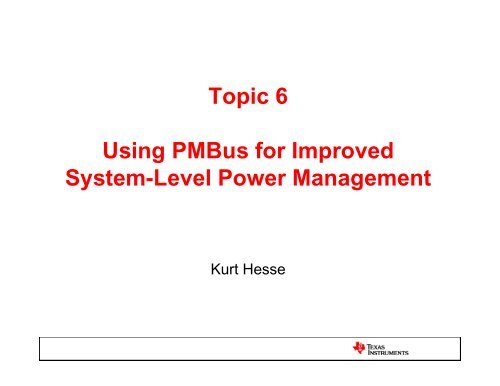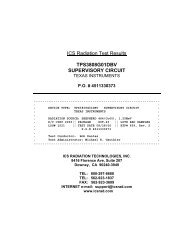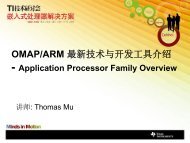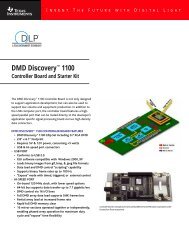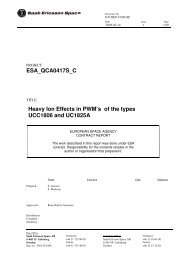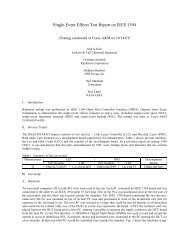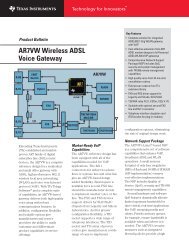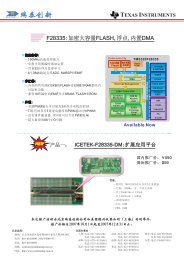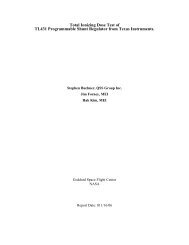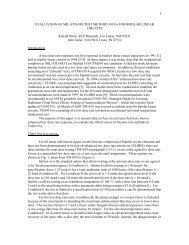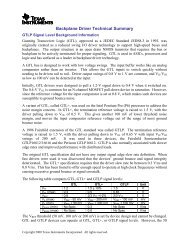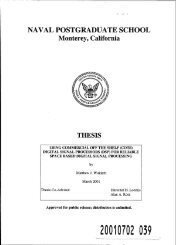What is PMBus?
What is PMBus?
What is PMBus?
Create successful ePaper yourself
Turn your PDF publications into a flip-book with our unique Google optimized e-Paper software.
Topic 6<br />
Using <strong>PMBus</strong> for Improved<br />
System-Level Power Management<br />
KKurt t Hesse<br />
H
<strong>PMBus</strong> overview<br />
Agenda<br />
Some tasks and <strong>PMBus</strong> solutions<br />
Brief design example<br />
6-2
Evolution<br />
Newer systems require more advanced<br />
capabilities<br />
Supplies evolving in:<br />
Si Size and d iintegration i<br />
Functionality<br />
Flexibility<br />
Monitoring and control<br />
<strong>PMBus</strong> <strong>is</strong> an answer<br />
6-3
Open standard<br />
<strong>What</strong> <strong>is</strong> <strong>PMBus</strong>?<br />
Serial interface to controller<br />
Electrical ect ca spec specification cat o pprotocol otoco aand d co command a d language a guage<br />
Anyone can use – royalty free<br />
Controlled by Special Interest Group (SIG):<br />
www.pmbus.org<br />
Communication only<br />
NNo fform factor f t<br />
No I/O specification<br />
No specific functionality requirement<br />
No pinout<br />
Implementation of the physical supply <strong>is</strong><br />
completely open<br />
6-4
Si Single l master t – HHost t<br />
Typical <strong>PMBus</strong> System<br />
One or more slaves – Supplies<br />
Bus:<br />
CLOCK and DATA<br />
required<br />
Central Control Unit:<br />
System Host/Bus Master<br />
CNTL and SMBALRT optional<br />
Each device has unique address<br />
Only communication between<br />
host and supplies – no intersupply<br />
communication<br />
Power Supply:<br />
Bus Slave<br />
CLK<br />
DATA<br />
CNTL<br />
SMBALRT<br />
Write Protect Address 1<br />
Power Supply:<br />
Bus Slave<br />
CLK<br />
DATA<br />
CNTL<br />
SMBALRT<br />
Write Protect Address 2<br />
Power Supply:<br />
Bus Slave<br />
CLK<br />
DATA<br />
CNTL<br />
SMBALRT<br />
Write Protect Address 3<br />
6-5
PC<br />
Development stage<br />
Automatic Test<br />
<strong>What</strong> <strong>is</strong> the Host?<br />
Central Control Unit:<br />
Equipment<br />
System Host/Bus Master<br />
Production testing<br />
Final parameter trim<br />
Microcontroller/<br />
Power Supply:<br />
Bus Slave<br />
CLK<br />
DATA<br />
CNTL<br />
SMBALRT<br />
Write Protect Address 1<br />
Power Supply:<br />
Bus Slave<br />
CLK<br />
DATA<br />
CNTL<br />
SMBALRT<br />
Write Protect Address 2<br />
Microprocessor<br />
CLK<br />
DATA<br />
CNTL<br />
Power Supply:<br />
Bus Slave<br />
SMBALRT<br />
In the field<br />
Power sequencing, fault<br />
management, etc.<br />
Write Protect Address 3<br />
6-6
<strong>PMBus</strong>-Converter Architecture<br />
Si Similar il tto standard t d d controller t ll<br />
<strong>PMBus</strong> interface addon <strong>is</strong> typical<br />
Hooks into controller for <strong>PMBus</strong> functions<br />
NVRAM<br />
Store operating parameters, user data, etc.<br />
Input<br />
Power Current<br />
Sense<br />
<strong>PMBus</strong> to<br />
System<br />
Host<br />
RReference f<br />
Voltage<br />
SSense<br />
CLK<br />
DATA<br />
SMBALRT<br />
CNTL<br />
Error Amplifier<br />
and Pulse-Width<br />
Pulse Width<br />
Modulator<br />
<strong>PMBus</strong> Interface<br />
Power Stage<br />
Current Sense<br />
Voltage Sense<br />
Nonvolatile<br />
Memory<br />
Output<br />
PPower<br />
6-7
Ancestry of <strong>PMBus</strong><br />
Inter-Integrated Circuit – Philips development<br />
Simple serial 2-wire bus<br />
VVulnerable l bl<br />
Excessive clock stretching causing bus lockup<br />
No standard error check<br />
6-8
Ancestry of <strong>PMBus</strong><br />
System y Management g Bus – www.smbus.orgg<br />
Fixes bus lockup from clock stretching <strong>is</strong>sues<br />
Bus times out and resets<br />
Standard error checking defined<br />
HHost-notify t tif protocol t l defined d fi d<br />
Slave device can alert master when needed<br />
6-9
Ancestry of <strong>PMBus</strong><br />
Power Management Bus – www.pmbus.org<br />
Outgrowth of SMBus<br />
Notable differences<br />
Host-notify protocol <strong>is</strong> optional<br />
Group-command protocol<br />
Multiple devices can execute commands at the same time<br />
6-10
<strong>PMBus</strong> Compliance<br />
<strong>PMBus</strong> specification <strong>is</strong> in two parts<br />
Compliant converters must:<br />
Meet all Part I specifications<br />
Hardware interface (electrical, timing)<br />
Implement at least one command<br />
Other than manufacturer specific<br />
Supported commands must comply with Part II of<br />
the specification<br />
Command language<br />
Non-supported Non supported command<br />
Also:<br />
Respond according to Part II<br />
Must be able start without <strong>PMBus</strong> communication<br />
6-11
Not hard!<br />
Simple sequential<br />
commands<br />
Example sets<br />
converter’s:<br />
OOvercurrent t limit li it<br />
Input turn-on voltage<br />
Soft-start time<br />
Usage Mechanics<br />
Parameters to power-up p p<br />
defaults<br />
Prior parts of<br />
the host<br />
program<br />
IOUT_OC_FAULT_LIMIT (Converter A, 10 A);<br />
VIN_ON (Converter A, 10 V);<br />
TON_RISE (Converter A, 5 ms);<br />
STORE STORE_DEFAULT_ALL DEFAULT ALL (Converter A);<br />
Remainder of<br />
the host<br />
program<br />
6-12
<strong>PMBus</strong> Command<br />
1 7 1 1 8 1 8<br />
One or more Data Bytes<br />
1 8 1 8 1 1<br />
S Device Address W A Command Code A Data Byte A ... Data Byte A PEC A P<br />
CLK CLK<br />
DATA DATA<br />
START Condition STOP Condition<br />
<strong>PMBus</strong> command <strong>is</strong> fairly simple<br />
START and STOP conditions have DATA-change<br />
state while CLK <strong>is</strong> high.<br />
Normal transfer: DATA <strong>is</strong> stable while CLK <strong>is</strong> high<br />
6-13
Types of Commands Available<br />
On, off, and margin<br />
testing<br />
OOutput t t voltage lt related l t d<br />
Addressing, memory<br />
communication communication, and<br />
capability<br />
Fault au handling a d g<br />
Sequencing<br />
Status<br />
Telemetry<br />
Other<br />
Deal with turning<br />
converter on and off,<br />
output margining<br />
Commands in group:<br />
OPERATION<br />
ON_OFF_CONFIG<br />
VOUT_MARGIN_HIGH<br />
VOUT_MARGIN_LOW<br />
6-14
Types of Commands Available<br />
On, off, and margin<br />
testing<br />
Output voltage related<br />
Addressing, memory<br />
communication communication, and<br />
capability<br />
Fault handlingg<br />
Sequencing<br />
Status<br />
Telemetry<br />
Other<br />
Commands affect the<br />
output voltage of the<br />
converter<br />
Commands in group:<br />
VOUT_COMMAND<br />
VOUT_TRIM<br />
VOUT_CAL_OFFSET<br />
VOUT_SCALE_LOOP<br />
6-15
Types of Commands Available<br />
On, off, and margin<br />
testing<br />
Output voltage related<br />
Addressing, memory<br />
communication communication, and<br />
capability<br />
Fault handlingg<br />
Sequencing<br />
Status<br />
Telemetry<br />
Other<br />
Deal with device<br />
addressing, memory,<br />
communication, and<br />
capability of the converter<br />
Commands in group:<br />
STORE_DEFAULT_ALL<br />
STORE STORE_DEFAULT_CODE<br />
DEFAULT CODE<br />
PHASE, PAGE<br />
WRITE_PROTECT<br />
6-16
Types of Commands Available<br />
On, off, and margin<br />
testing<br />
Output voltage related<br />
Addressing, memory<br />
communication communication, and<br />
capability<br />
Fault handlingg<br />
Sequencing<br />
Status<br />
Telemetry<br />
Other<br />
Determine how converter<br />
responds to faults<br />
Defines what fault and<br />
warning levels are<br />
Commands in group:<br />
IOUT_OC_WARN_LIMIT<br />
IOUT_OC_FAULT_LIMIT<br />
IOUT_OC_FAULT_RESPONSE<br />
Many others<br />
6-17
Types of Commands Available<br />
On, off, and margin<br />
testing<br />
Output voltage related<br />
Addressing, memory<br />
communication communication, and<br />
capability<br />
Fault handlingg<br />
Sequencing<br />
Status<br />
Telemetry<br />
Other<br />
Deals with timing of<br />
startup and shutdown<br />
Commands in group:<br />
TON_DELAY<br />
TON_RISE<br />
TOFF_DELAY<br />
TOFF_FALL<br />
6-18
Enable<br />
CNTL<br />
VIN_ON<br />
OPERATION<br />
Power-On Sequencing<br />
0<br />
Enable<br />
TON_DELAY<br />
TON_RISE<br />
Output<br />
Voltage<br />
Time<br />
6-19
Enable<br />
CNTL<br />
VIN_OFF<br />
OPERATION<br />
Power-Off Sequencing<br />
0<br />
Enable<br />
TOFF_ DELAY<br />
Output<br />
Voltage<br />
TOFF_FALL<br />
Time<br />
6-20
Types of Commands Available<br />
On, off, and margin<br />
testing<br />
Output voltage related<br />
Addressing, memory<br />
communication communication, and<br />
capability<br />
Fault handlingg<br />
Sequencing<br />
Status<br />
Telemetry<br />
Other<br />
Information about<br />
status of converter<br />
Commands in group:<br />
STATUS_BYTE<br />
STATUS_WORD<br />
STATUS_IOUT<br />
STATUS_CML<br />
6-21
STATUS_BYTE and STATUS_WORD<br />
STATUS_WORD<br />
High Byte<br />
7– VOUT OU<br />
6– IOUT/POUT<br />
5– INPUT<br />
4– MFR<br />
33– POWER POWER_GOOD GOOD<br />
2– FANS<br />
1– OTHER<br />
0– UNKNOWN<br />
7– BUSY<br />
6– OFF<br />
Low Byte<br />
5–VOUT 5– VOUT_OV OV<br />
4– IOUT_OC<br />
3– VIN_UV<br />
2– TEMPERATURE<br />
1– CML<br />
0– None of the above<br />
STATUS_BYTE part of<br />
STATUS_WORD<br />
Most flags have more<br />
detailed status commands<br />
STATUS_BYTE<br />
7– BUSY<br />
6– OFF<br />
5–VOUT 5– VOUT_OV OV<br />
4– IOUT_OC<br />
3– VIN_UV<br />
2– TEMPERATURE<br />
1– CML<br />
0– None of the above<br />
6-22
Types of Commands Available<br />
On, off, and margin<br />
testing<br />
Output voltage related<br />
Addressing, memory<br />
communication communication, and<br />
capability<br />
Fault handlingg<br />
Sequencing<br />
Status<br />
Telemetry<br />
Other<br />
Report back converter<br />
operating conditions<br />
Commands in group:<br />
READ_VIN<br />
READ_VOUT<br />
READ_IIN<br />
READ READ_IOUT IOUT<br />
READ_DUTY_CYCLE<br />
READ READ_FREQUENCY<br />
FREQUENCY<br />
Several others<br />
6-23
Types of Commands Available<br />
On, off, and margin<br />
testing<br />
Output voltage related<br />
Addressing, memory<br />
communication communication, and<br />
capability<br />
Fault handlingg<br />
Sequencing<br />
Status<br />
Telemetry<br />
Other<br />
Commands that don’t<br />
really fit elsewhere:<br />
FREQUENCY FREQUENCY_SWITCH SWITCH<br />
VIN_ON<br />
VIN_OFF<br />
IOUT_CAL_GAIN<br />
IOUT_CAL_OFFSET<br />
Other classes not<br />
mentioned:<br />
Manufacturer data<br />
User data<br />
6-24
<strong>PMBus</strong> overview<br />
Agenda<br />
Some tasks and <strong>PMBus</strong> solutions<br />
Brief design example<br />
6-25
<strong>PMBus</strong> in the System<br />
Converter may not support all <strong>PMBus</strong><br />
commands<br />
Consider tasks needed<br />
Match capability to task requirements<br />
For example<br />
Sequencing<br />
Margining g g<br />
Monitoring, etc.<br />
6-26
Sequencing<br />
Several ways to accompl<strong>is</strong>h with <strong>PMBus</strong><br />
facilities:<br />
Remote enable<br />
CNTRL pin<br />
OPERATION command<br />
Time delay<br />
Open-loop Open loop tracking<br />
6-27
System<br />
Host<br />
CNTL<br />
Remote Enable<br />
<strong>PMBus</strong><br />
Converter A<br />
Power Good<br />
Converter B<br />
<strong>PMBus</strong><br />
CNTL<br />
PPower Good G d<br />
Vout<br />
Vout<br />
0<br />
Output<br />
Voltage<br />
Simple p – not really y <strong>PMBus</strong> solution<br />
CNTL <strong>is</strong> like ENABLE pin<br />
CNTL A<br />
CNTL B<br />
TON_RISE(A)<br />
TON_RISE(B)<br />
Controlled individually – conventional<br />
Similar operation possible using OPERATION<br />
commands over <strong>PMBus</strong><br />
Time<br />
Converter B<br />
Converter A<br />
6-28
0<br />
Output<br />
Voltage<br />
Time-Delay Sequencing<br />
EEnable bl<br />
TON_DELAY(B)<br />
TON_RISE(A)<br />
TON TON_RISE(B) RISE(B)<br />
Time<br />
Converter B<br />
Converter A<br />
Converters programmed with startup delay (TON_RISE)<br />
Enabled simultaneously<br />
Eases burden on system host<br />
6-29
0<br />
Enable<br />
Output<br />
Voltage g<br />
Time-Delay Off<br />
Time<br />
Similar to previous – using TOFF_DELAY<br />
Watch fall times if TOFF TOFF_FALL FALL not supported<br />
Both converters d<strong>is</strong>abled simultaneously<br />
6-30
0<br />
Tracking<br />
Startup methodology keeping multiplevoltage<br />
rails close<br />
Startup<br />
Possibly shutdown<br />
Startup and shutdown only here - Not for DDR<br />
Output<br />
Voltage<br />
Rail 1<br />
Rail 2<br />
Time<br />
6-31
0<br />
<strong>PMBus</strong>-Tracking Startup<br />
Enable<br />
TON_RISE(B)<br />
TON_RISE(A)<br />
Converter B<br />
Converter A<br />
V V<br />
OOutput t t<br />
out(A) out(B)<br />
Voltage =<br />
Time<br />
Set slopes of r<strong>is</strong>e times equal<br />
TON _ RISE(A) TON _ RISE(B)<br />
Requires very fine control of TON_RISE<br />
6-32
0<br />
<strong>PMBus</strong>-Tracking Shutdown<br />
Converter B<br />
Converter A<br />
Enable<br />
TOFF TOFF_DELAY(A) DELAY(A)<br />
Output<br />
Voltage<br />
Time<br />
Vout(A) Vout(B)<br />
=<br />
TOFF_FALL(A) TOFF_FALL(B)<br />
TOFF_FALL(B)<br />
TOFF_FALL(A)<br />
Set down slopes equal – Requires TOFF_FALL support<br />
Note off delay required for lower voltage output<br />
6-33
Margining<br />
Vary output voltages to test system<br />
Requires q either<br />
Converter support<br />
External device(s) to implement<br />
<strong>PMBus</strong> support<br />
Variable margin g voltages g<br />
Variable transition rate<br />
Programmable g fault response p during g margin g<br />
Set margin voltages and use OPERATION<br />
command to execute<br />
6-34
Margin<br />
Output<br />
Voltage<br />
Margin Illustrated<br />
VOUT_TTRANSITION_RATE<br />
Time<br />
VOUT_MARGIN_HIGH<br />
Margin initiated using OPERATION command<br />
Transition rate and margin voltage are variable<br />
MMuch ch more flexible fle ible than hard hardware are sol solution<br />
tion<br />
6-35
Timing Issue<br />
How to synchronize <strong>PMBus</strong> commands<br />
Startup/tracking require known timing relationships<br />
Serial bus not inherently good<br />
<strong>PMBus</strong> solution:<br />
Group Command Protocol<br />
6-36
<strong>PMBus</strong> Group Command<br />
OneormoreDataBytes<br />
One or more Data Bytes<br />
1 7 1 1 8 1 8 1 8 1 8 1<br />
S Device 1 Address W A Command Code A Data Byte A ... Data Byte A PEC 1 A<br />
1 7 1 1 8 1 8<br />
One or more Data Bytes<br />
1 8 1 8 1<br />
S Device 2 Address W A Command Code A Data Byte A ... Data Byte A PEC 2 A<br />
One or more Data Bytes<br />
1 7 1 1 8 1 8 1 8 1 8 1 1<br />
S Device N Address W A Command Code A Data Byte A ... Data Byte A PEC N A P<br />
S START Bit P STOP Bit A ACK Bit Device N Address<br />
Seven-bit<br />
device<br />
address<br />
Lik Like single i l command d except: t<br />
No STOP after first command<br />
PEC<br />
Packet-error<br />
check byte.<br />
START repeats and next command <strong>is</strong> <strong>is</strong>sued<br />
STOP <strong>is</strong>sued after final command<br />
W<br />
...<br />
...<br />
Read/Write eighth<br />
bit of address byte<br />
set to WRITE mode.<br />
Commands simultaneously executed after the STOP<br />
6-37
<strong>PMBus</strong> Group Command<br />
Group command caveats:<br />
1. No more than one command in a group<br />
can be addressed to a single slave<br />
device<br />
2. No command in the group can require<br />
the slave to respond over the <strong>PMBus</strong><br />
6-38
Other Uses of <strong>PMBus</strong><br />
Change system power parameters<br />
Factory or field<br />
No hardware modification<br />
Accidental overvoltage protection<br />
Inadvertent/erroneous command<br />
System monitoring<br />
Compensation and capacitive loading<br />
Fault and incident tracking<br />
6-39
<strong>PMBus</strong> overview<br />
Agenda<br />
Some tasks and <strong>PMBus</strong> solutions<br />
Brief design example<br />
6-40
Design Example<br />
Important: Not all converters support all<br />
functions<br />
Determine necessary functions<br />
Select converter or controller accordingly<br />
6-41
Target Specifications<br />
Power supply for two processors in communications rack<br />
Core and I/O for each<br />
Input voltage: 12 V<br />
Core output voltage: 1.2 V at 10 A per processor<br />
Must be able to change from 1.1 V to 1.2 V<br />
I/O output voltage: 3.3 V at 3 A per processor<br />
Sequencing required: Core up first, then I/O’s<br />
Margin testing support for field and factory<br />
Output voltage and current monitoring<br />
Minimal cost<br />
6-42
<strong>PMBus</strong> Features Required<br />
Nonvolatile memory<br />
Store default operating parameters<br />
PPower-on sequencing i<br />
TON_DELAY<br />
VOUT VOUT_TRIM TRIM command<br />
To adjust nominal output voltage on cores<br />
Margin commands<br />
VOUT_MARGIN_HIGH, VOUT_MARGIN_LOW, OPERATION<br />
VOUT_TRANSITION_RATE nice to have<br />
READ_VOUT, READ_IOUT<br />
Monitor output power<br />
READ READ_POUT POUT would ld work k too<br />
t<br />
6-43
Proposed Solution<br />
FFusion i PPower Peripherals<br />
P i h l<br />
UCD9240<br />
UCD9240<br />
Digital <strong>PMBus</strong> controller<br />
Features<br />
Up to 4 independent rail control<br />
±1-mV feedback resolution<br />
HHardware d accelerated l t d di digital it l<br />
compensator<br />
12-bit monitoring of supply<br />
parameters t<br />
Programmable softstart and stop<br />
Nonvolatile memory with ECC<br />
Supports voltage tracking<br />
Programmable margining and<br />
sequencing q g<br />
PC-based design tools<br />
PWR<br />
GND<br />
BPCAP<br />
EAP4<br />
EAN4<br />
EAP3<br />
EAN3<br />
EAP2<br />
EAN2<br />
EAP1<br />
EAN1<br />
5<br />
6<br />
ADDR-00<br />
ADDR-01<br />
CS-1A<br />
CS-1B<br />
CS-2A<br />
CS-2B<br />
CS-3A<br />
CS-3B<br />
CS-4A<br />
CS-4B<br />
VIN<br />
Vtrack<br />
Temperature<br />
Diff<br />
Amp<br />
Error ADC<br />
Error ADC<br />
ADC<br />
12-Bit<br />
200 ksps<br />
Error ADC<br />
Error ADC<br />
Ref<br />
Error<br />
Amp<br />
6<br />
6<br />
6<br />
6-Bit<br />
ADC<br />
Analog Comparators<br />
Ref 1<br />
Ref 2<br />
Compensator<br />
3P/3Z IIR<br />
Compensator<br />
3P/3Z IIR<br />
Compensator<br />
3P/3Z IIR<br />
TRIP 1<br />
TRIP 2<br />
16<br />
16<br />
16<br />
Compensator<br />
6<br />
IIR<br />
3P/3Z<br />
Coeff.<br />
Regs<br />
16<br />
ARM-7 Flash<br />
Core Memory<br />
with ECC<br />
Digital<br />
High-Res<br />
PWM<br />
Digital<br />
High High-Res Res<br />
PWM<br />
Digital<br />
High-Res<br />
PWM<br />
Digital<br />
High-Res<br />
PWM<br />
SRE<br />
Control<br />
DPWM-4A<br />
DPWM-4B<br />
FAULT-4A<br />
FAULT-4B<br />
DPWM-3A<br />
DPWM-3B<br />
FAULT FAULT-3A 3A<br />
FAULT-3B<br />
DPWM-2A<br />
DPWM-2B<br />
FAULT-2A<br />
FAULT-2B<br />
DPWM-1A<br />
DPWM-1B<br />
FAULT-1A<br />
FAULT-1B<br />
SYNC-IN<br />
SYNC-OUT<br />
SRE-4B<br />
SRE-4A<br />
SRE-3B<br />
SRE-3A<br />
SRE SRE-2B 2B<br />
SRE-2A<br />
SRE-1B<br />
SRE-1A<br />
TRIP 3<br />
Ref 3<br />
Vreg<br />
<strong>PMBus</strong>-Clk<br />
<strong>PMBus</strong>-Data<br />
Osc<br />
<strong>PMBus</strong> <strong>PMBus</strong>-Alert<br />
TRIP 4 <strong>PMBus</strong> <strong>PMBus</strong>-Cntl<br />
Cntl<br />
Ref 4 POR/BOR<br />
6-44
Vin<br />
+Vsens-rail1<br />
-Vsens-rail1<br />
+Vsens-rail2<br />
-Vsens-rail2<br />
+Vsens-rail3<br />
-Vsens-rail3 Vsens rail3<br />
+Vsens-rail4<br />
-Vsens-rail4<br />
Isens-rail1<br />
Isens Isens-rail2 rail2<br />
Isens-rail3<br />
Isens-rail4<br />
To<br />
<strong>PMBus</strong><br />
host<br />
Power<br />
Good<br />
3.3 V<br />
50 EAp1<br />
51 EAn1<br />
52 EAp2<br />
53 EAn2<br />
54 EAp3<br />
55 EAn3<br />
56 EAp4<br />
57 EAn4<br />
61 AddrSens0<br />
60 AddrSens1<br />
V33FB<br />
V33A<br />
V33D<br />
3.3 V<br />
58 46 45 7 44 47<br />
V33DIO-1<br />
V33DIO-2<br />
BPCap<br />
UCD9240<br />
Proposed Solution<br />
DPWM-1A 17<br />
DPWM-1B 18<br />
DPWM-2A 19<br />
DPWM-2B 20<br />
DPWM-3A 21<br />
DPWM DPWM-4A 4A 23<br />
FAULT -1A 11<br />
FAULT -1B 12<br />
FAULT -2A 13<br />
FAULT -2B 14<br />
FAULT -3A 25<br />
FAULT -4A 34<br />
TLV1117-ADJ<br />
Vin<br />
Vout<br />
8V<br />
Isens-rail1<br />
+Vsens-rail1<br />
-Vsens-rail1<br />
59 CS-1A (COMP1)<br />
SRE-1A 22<br />
Isens-rail2<br />
3 CS CS-2A 2A (COMP2)<br />
SRE-1B 24<br />
+V +Vsens-rail2 il2<br />
2 CS-3A (COMP3)<br />
SRE-2A 33<br />
-Vsens-rail2<br />
1 CS-4A (COMP4)<br />
SRE-2B 35<br />
63 CS-1B<br />
SRE-3A 29<br />
62 CS-2B<br />
SRE-4A 30<br />
4 Vin<br />
5 Vtrack<br />
6 Temp<br />
15 <strong>PMBus</strong> <strong>PMBus</strong>-CLK CLK<br />
16 <strong>PMBus</strong>-DATA<br />
27 <strong>PMBus</strong>-ALERT<br />
28 <strong>PMBus</strong>-CTRL<br />
39 PowerGood<br />
9 /Reset<br />
AGND-1<br />
AGND-2<br />
AGND-3<br />
DGND-1<br />
DGND-2<br />
DGND-3<br />
49 48 64 8 26 43<br />
TMUX-0 31<br />
TMUX-1 32<br />
TMUX-2 42<br />
FAN FAN-PWM PWM 41<br />
FAN-TACH 36<br />
SYNC-IN 38<br />
SYNC-OUT 37<br />
/TRST 40<br />
TRCK 10<br />
Isens-rail3<br />
+Vsens-rail3<br />
-Vsens-rail3<br />
Isens-rail4<br />
+Vsens-rail4<br />
-Vsens-rail4<br />
8 V<br />
UCD72XX<br />
8 V<br />
8 V<br />
8 V<br />
Power Stage<br />
Power Stage<br />
Vcore1<br />
Vin Vcore2<br />
Vin<br />
Power Stage<br />
Vin<br />
Power Stage g<br />
VI/O1<br />
VI/O2<br />
6-45
Conclusions<br />
<strong>PMBus</strong> as a standard supports a wide range<br />
of functionality<br />
Many system-level tasks can be accompl<strong>is</strong>hed<br />
by the facilities provided by <strong>PMBus</strong><br />
Converters won’t generally fully support<br />
<strong>PMBus</strong> command set<br />
Match system requirements to converter capability<br />
6-46


